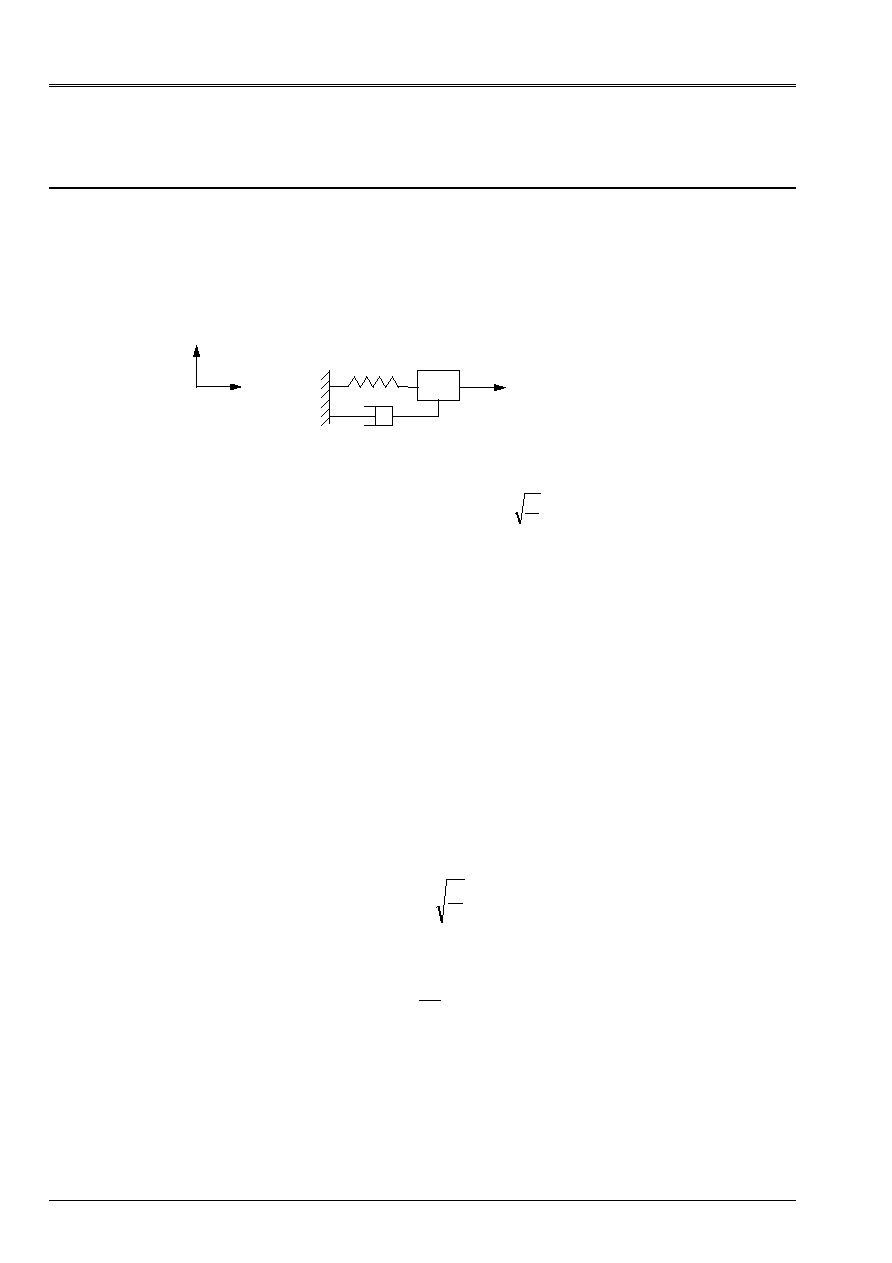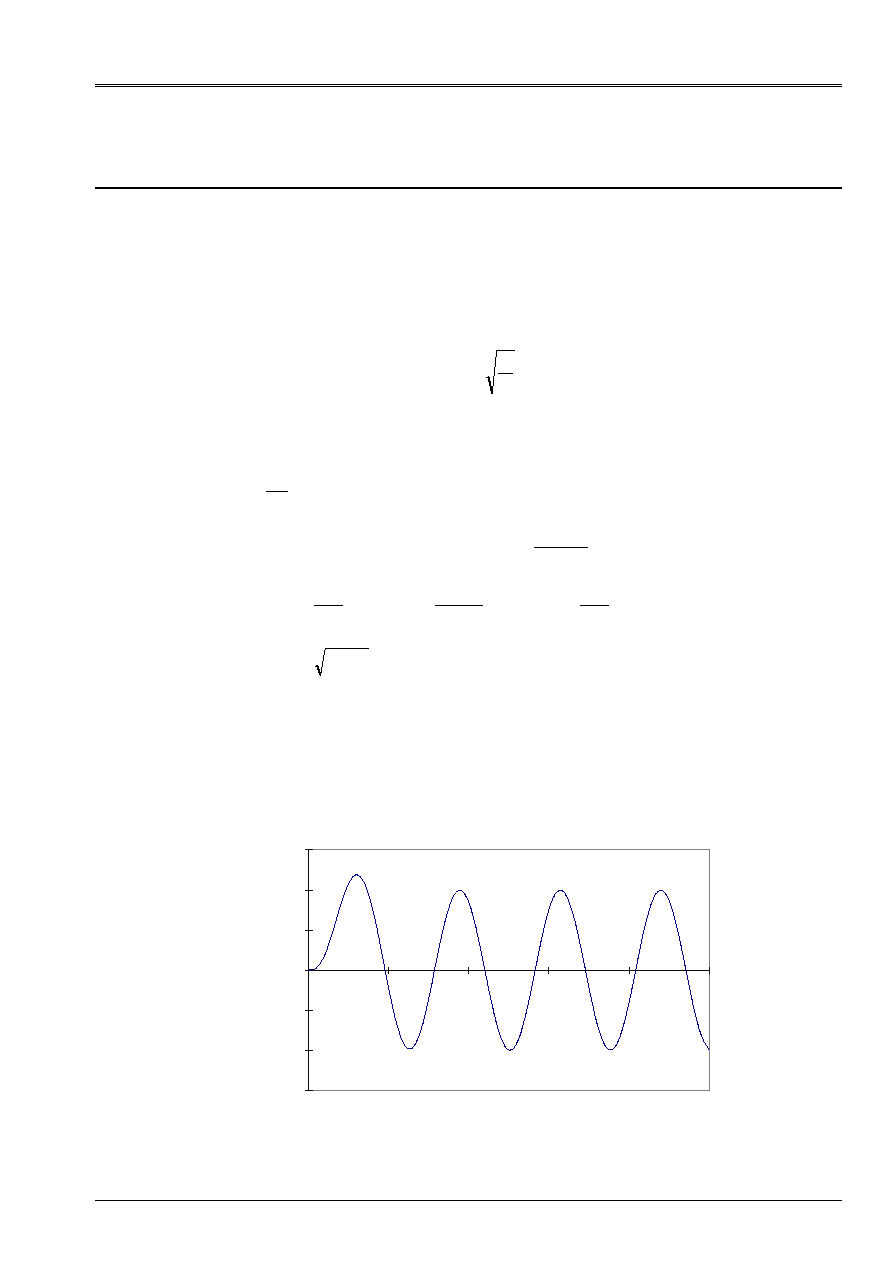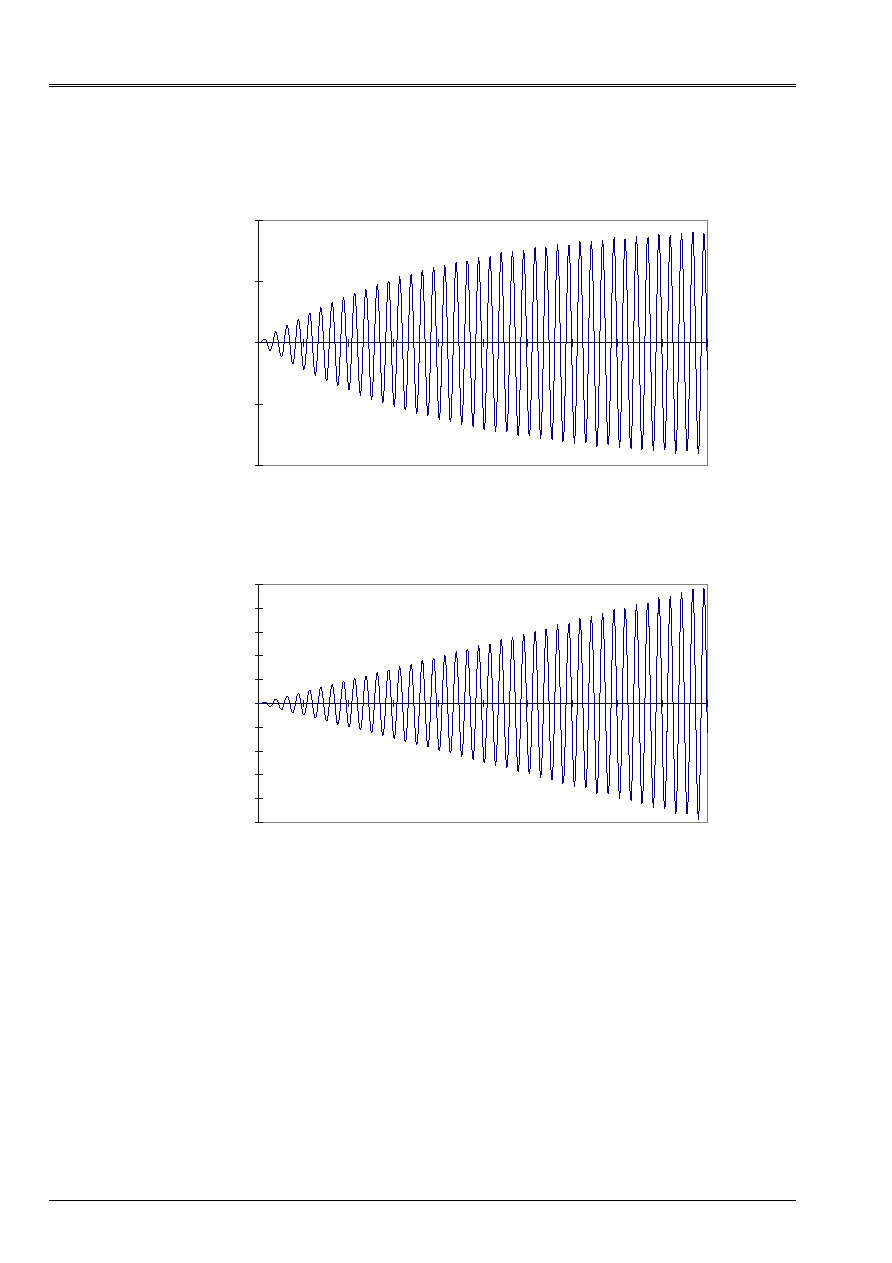
Code_Aster
®
Version
6.4
Titrate:
SDLD321 - Transitory dynamic response of a harmonic oscillator
Date:
17/02/04
Author (S):
E. BOYERE, T. QUESNEL
Key
:
V2.01.321-A
Page:
1/12
Manual of Validation
V2.01 booklet: Linear dynamics of the discrete systems
HT-66/04/005/A
Organization (S):
EDF-R & D/AMA, IRCN
Manual of Validation
V2.01 booklet: Linear dynamics of the discrete systems
V2.01.321 document
SDLD321 - Transitory dynamic response of one
harmonic oscillator with damping
variable
Summary:
The system considered is a harmonic oscillator with 1 D.D.L. under harmonic excitation with resonance.
Various depreciation will be considered:
·
critical damping,
·
average damping,
·
very weak damping.
Via this problem, one tests the various algorithms of the control
DYNA_TRAN_MODAL
[U4.54.03] and their capacities to deal with problems with extreme damping. The results are compared
with the exact analytical solutions.

Code_Aster
®
Version
6.4
Titrate:
SDLD321 - Transitory dynamic response of a harmonic oscillator
Date:
17/02/04
Author (S):
E. BOYERE, T. QUESNEL
Key
:
V2.01.321-A
Page:
2/12
Manual of Validation
V2.01 booklet: Linear dynamics of the discrete systems
HT-66/04/005/A
1
Problem of reference
1.1 Geometry
The system is composed of a mass, a spring and a shock absorber. It admits a single degree of
freedom in translation.
y, v
X, U
F
0
sin (
T)
C
m
B
With
K
: pulsation of excitation corresponding
with the resonance of the system not deadened
= km
1.2
Material properties
Stiffness of connection: K = 25.10
3
N.m
- 1
Specific mass: m = 10 kg
Viscous damping:
C = C
critical
; C = 0,01 C
critical
; C = 10
- 5
C
critical
with C
critical
= 1.000 kg.s
- 1
1.3
Boundary conditions and loadings
Embedded end A.
Force harmonic according to X at the frequency of resonance at point b:
F (T) = F
0
sin (
T) for T 0 with F
0
= 5 NR and
= km
= 50 rad.s
- 1
.
1.4 Conditions
initial
The system is at rest with T = 0:
()
U 0
0
=
and
()
dt 0
0
=
.

Code_Aster
®
Version
6.4
Titrate:
SDLD321 - Transitory dynamic response of a harmonic oscillator
Date:
17/02/04
Author (S):
E. BOYERE, T. QUESNEL
Key
:
V2.01.321-A
Page:
3/12
Manual of Validation
V2.01 booklet: Linear dynamics of the discrete systems
HT-66/04/005/A
2
Reference solution
2.1
Method of calculation used for the reference solution
The simple oscillator checks the following equation:
()
m u.a. the U.K.U
F
T
&&
&
sin
+
+
=
0
with
()
()
0
0
0
0
=
=
U
U
&
and
: own pulsation of the oscillator
= km
Critical damping is C
critical
= 2m
.
The solution for C = C
critical
is:
()
(
)
()
[
]
U T
F
K E
T
T
T
=
+
-
-
0
2
1
cos
The solution for a subcritical damping such as
C
C
critical
=
is:
()
(
)
(
)
()
U T
E
F
K
T
F
K
T
F
K
T
T
D
D
D
=
+
-
-
0
0
0
2
2
2
cos
sin
cos
with
D
=
-
1
2
2.2
Results of reference
Displacement and speed of the point B.
Displacement for critical damping
- 1,50E-04
- 1,00E-04
- 5,00E-05
0,00E+00
5,00E-05
1,00E-04
1,50E-04
0
0,1
0,2
0,3
0,4
0,5
time (S)
U
B
(m
)

Code_Aster
®
Version
6.4
Titrate:
SDLD321 - Transitory dynamic response of a harmonic oscillator
Date:
17/02/04
Author (S):
E. BOYERE, T. QUESNEL
Key
:
V2.01.321-A
Page:
4/12
Manual of Validation
V2.01 booklet: Linear dynamics of the discrete systems
HT-66/04/005/A
Displacement for the damping of 1%
- 1,00E-02
- 5,00E-03
0,00E+00
5,00E-03
1,00E-02
0
0,5
1
1,5
2
2,5
3
3,5
4
4,5
5
time (S)
U
B
(m)
Displacement for the damping of 0,001%
- 2,50E-02
- 2,00E-02
- 1,50E-02
- 1,00E-02
- 5,00E-03
0,00E+00
5,00E-03
1,00E-02
1,50E-02
2,00E-02
2,50E-02
0
0,5
1
1,5
2
2,5
3
3,5
4
4,5
5
time (S)
U
B
(m)
2.3
Uncertainty on the solution
Exact analytical solution.

Code_Aster
®
Version
6.4
Titrate:
SDLD321 - Transitory dynamic response of a harmonic oscillator
Date:
17/02/04
Author (S):
E. BOYERE, T. QUESNEL
Key
:
V2.01.321-A
Page:
5/12
Manual of Validation
V2.01 booklet: Linear dynamics of the discrete systems
HT-66/04/005/A
3 Modeling
With
3.1
Characteristics of modeling
Discrete elements of rigidity, damping and mass.
X
.
B
With
.
N1
N2
y
Characteristics of the elements:
DISCRETE: nodal mass
M_T_D_N
rigidity
linear
K_T_D_L
damping
linear
A_T_D_L
(c=c
critical
)
Boundary conditions: with the node N1 DDL_IMPO DX = DY = DZ = 0.
Names of the nodes: P
1
= N1, P
2
= N2.
Methods of calculation:
·
Integration on the modal basis with Newmark (
= 0,25, = 0,5)
No time
T = 10
- 3
S
·
Integration on the modal basis with Euler
No time
T = 10
- 3
S
Duration of observation: 0,5 S.
3.2
Characteristics of the mesh
A number of nodes: 2
A number of meshs and type: 1 mesh SEG2
3.3
Functionalities tested
Controls
DISCRETE AFFE_CARA_ELEM
NET “K_T_D_L'
NET
“A_T_D_L'
NODE
“M_T_D_N'
MODE_ITER_SIMULT
OPTION: “CENTER”
!FORMULATE REAL
CALC_FONC_INTERP FUNCTION
DYNA_TRAN_MODAL NEWMARK
AMOR_GENE
EULER

Code_Aster
®
Version
6.4
Titrate:
SDLD321 - Transitory dynamic response of a harmonic oscillator
Date:
17/02/04
Author (S):
E. BOYERE, T. QUESNEL
Key
:
V2.01.321-A
Page:
6/12
Manual of Validation
V2.01 booklet: Linear dynamics of the discrete systems
HT-66/04/005/A
4
Results of modeling A
4.1 Values
tested
·
Displacement of the point B
Displacement displacement
Displacement
Time
Reference
NEWMARK
Difference
EULER
Difference
(S)
(m)
Aster (m)
(%)
Aster (m)
(%)
0,06
1,18914 E4
1,18886 E4 0,023 1,18886
E4
0,024
0,12
9,42819 E5
9,42574 E5 0,026 9,47822
E5 0,531
0,19
9,97958 E5
9,97765 E5 0,019 9,96206
E5
0,176
0,25
9,97748 E5
9,97526 E5 0,022 9,99152
E5
0,141
0,31
9,78457 E5
9,78210 E5 0,025 9,83436
E5
0,509
0,38
9,88705 E5
9,88530 E5 0,018 9,84730
E5
0,402
0,44
9,99961 E5
9,99754 E5 0,021 9,99525
E5
0,044
·
Speed of the point B
Speed Speed
Speed
Time
Reference NEWMARK
Difference
EULER
Difference
(S)
(Mr. S
- 1
)
Aster (Mr. S
- 1
)
(%)
Aster (Mr. S
- 1
)
(%)
0,03
3,31400 E3
3,31363 E3 0,011 3,32568
E3
0,353
0,09
5,13760 E3
5,13729 E3 0,006 5,13627
E3
0,026
0,16
4,93337 E3
4,93354 E3 0,003
4,93088
E3
0,050
0,22
5,00087 E3
5,00087 E3 0,000
5,00133
E3
0,009
0,28
4,95298 E3
4,95284 E3 0,003 4,95297
E3
0,000
0,35
4,87813 E3
4,87836 E3 0,005
4,87801
E3
0,002
0,41
4,98415 E3
4,98423 E3 0,002
4,98409
E3
0,001
0,47
4,99041 E3
4,99035 E3 0,001 4,99043
E3 0,000
4.2 Remarks
The results are tested on the level of the peaks for the grain of observation selected (10
- 2
S) where values
are most significant.
The mode becomes quasi-permanent after the first period, it is what one must observe in
carrying out a transitory analysis.

Code_Aster
®
Version
6.4
Titrate:
SDLD321 - Transitory dynamic response of a harmonic oscillator
Date:
17/02/04
Author (S):
E. BOYERE, T. QUESNEL
Key
:
V2.01.321-A
Page:
7/12
Manual of Validation
V2.01 booklet: Linear dynamics of the discrete systems
HT-66/04/005/A
5 Modeling
B
5.1
Characteristics of modeling
Discrete elements of rigidity, damping and mass.
X
.
B
With
.
N1
N2
y
Characteristics of the elements:
DISCRETE: nodal mass
M_T_D_N
rigidity
linear
K_T_D_L
damping
linear
A_T_D_L
(C = 0,01 C
critical
)
Boundary conditions: with the node N1 DDL_IMPO DX = DY = DZ = 0.
Names of the nodes: P
1
= N1, P
2
= N2.
Methods of calculation:
·
Integration on the modal basis with Fu-Devogelaere
No time
T = 10
- 3
S
·
Integration on the modal basis with
T adaptive
No initial time
T = 10
- 3
S
Duration of observation: 5 S.
5.2 Characteristics of the mesh
A number of nodes: 2
A number of meshs and type: 1 mesh SEG2
5.3
Functionalities tested
Controls
DISCRETE AFFE_CARA_ELEM
NET
“K_T_D_L'
NET
“A_T_D_L'
NODE
“M_T_D_N'
MODE_ITER_SIMULT
OPTION: “CENTER”
!FORMULATE REAL
CALC_FONC_INTERP FUNCTION
DYNA_TRAN_MODAL DEVOGE
AMOR_REDUIT
ADAPT
AMOR_GENE

Code_Aster
®
Version
6.4
Titrate:
SDLD321 - Transitory dynamic response of a harmonic oscillator
Date:
17/02/04
Author (S):
E. BOYERE, T. QUESNEL
Key
:
V2.01.321-A
Page:
8/12
Manual of Validation
V2.01 booklet: Linear dynamics of the discrete systems
HT-66/04/005/A
6
Results of modeling B
6.1 Values
tested
·
Displacement of the point B
Displacement displacement
Displacement
Time
Reference DEVOG Difference
ADAPT
Difference
(S)
(m)
Aster (m)
(%)
Aster (m)
(%)
0,06
3,06503 E4
3,06503 E4 0,000 3,06481
E4
0,007
0,13
5,93807 E4
5,93807 E4 0,000 5,93696
E4
0,019
0,25
1,17872 E3
1,17872 E3 0,000 1,17862
E3
0,009
0,69
2,91788 E3
2,91788 E3 0,000 2,91748
E3
0,014
1,01
3,83901 E3
3,83901 E3 0,000 3,83548
E3
0,092
2,32
6,68206 E3
6,68206 E3 0,000 6,68614
E3 0,061
3,64
8,19821 E3
8,19821 E3 0,000 8,20355
E3 0,065
4,96
9,00847 E3
9,00847 E3 0,000 9,01348
E3 0,056
·
Speed of the point B
Speed Speed
Speed
Time
Reference DEVOG Difference
ADAPT
Difference
(S)
(Mr. S
- 1
)
Aster (Mr. S
- 1
)
(%)
Aster (Mr. S
- 1
)
(%)
0,04
8,95997 E3
8,95997 E3 0,000
8,97145
E3 0,128
0,10
2,33271 E2
2,33271 E2
0,000 2,33492
E2
0,095
0,22
5,20590 E2
5,20590 E2
0,000 5,21002
E2
0,079
0,66
1,40500 E1
1,40500 E1 0,000
1,40593
E1 0,066
1,04
1,99889 E1
1,99889 E1 0,000
1,99923
E1 0,017
2,36
3,39933 E1
3,39933 E1
0,000 3,39703
E1
0,068
3,68
4,10585 E1
4,10585 E1 0,000
4,09991
E1
0,145
5,00
4,45309 E1
4,45309 E1
0,000 4,42239
E1
0,689
6.2 Remarks
The results are tested on the level of the peaks where the values are most significant.
The duration of selected observation makes it possible to see the effect of damping. However, in this
interval, the response of the point B remains always transitory but one is close to the steady state
whose scale of displacement is 10
- 2
Mr.

Code_Aster
®
Version
6.4
Titrate:
SDLD321 - Transitory dynamic response of a harmonic oscillator
Date:
17/02/04
Author (S):
E. BOYERE, T. QUESNEL
Key
:
V2.01.321-A
Page:
9/12
Manual of Validation
V2.01 booklet: Linear dynamics of the discrete systems
HT-66/04/005/A
7 Modeling
C
7.1
Characteristics of modeling
Discrete elements of rigidity, damping and mass.
X
.
B
With
.
N1
N2
y
Characteristics of the elements:
DISCRETE:
nodal mass
M_T_D_N
rigidity
linear
K_T_D_L
damping
linear
A_T_D_L
(C = 10
- 5
C
critical
)
Boundary conditions: with the node N1 DDL_IMPO DX = DY = DZ = 0.
Names of the nodes: P
1
= N1, P
2
= N2.
Methods of calculation:
·
Integration on the modal basis with Newmark (
= 0,25, = 0,5)
No time
T = 10
- 3
S
·
Integration on the modal basis with Euler
No time
T = 10
- 3
S
Duration of observation: 5 S.
7.2
Characteristics of the mesh
A number of nodes: 2
A number of meshs and type: 1 mesh SEG2
7.3
Functionalities tested
Controls
DISCRETE AFFE_CARA_ELEM
NET “K_T_D_L'
NET
“A_T_D_L'
NODE
“M_T_D_N'
MODE_ITER_SIMULT
OPTION: “CENTER”
!FORMULATE REAL
CALC_FONC_INTERP FUNCTION
DYNA_TRAN_MODAL NEWMARK
AMOR_GENE
EULER

Code_Aster
®
Version
6.4
Titrate:
SDLD321 - Transitory dynamic response of a harmonic oscillator
Date:
17/02/04
Author (S):
E. BOYERE, T. QUESNEL
Key
:
V2.01.321-A
Page:
10/12
Manual of Validation
V2.01 booklet: Linear dynamics of the discrete systems
HT-66/04/005/A
8
Results of modeling C
8.1 Values
tested
·
Displacement of the point B
Displacement displacement
Displacement
Time
Reference NEWMARK Difference
EULER
Difference
(S)
(m)
Aster (m)
(%)
Aster (m)
(%)
0,06
3,11105 E4
3,10936 E4 0,054 3,11181
E4
0,024
0,13
6,13250 E4
6,13016 E4 0,038 6,13380
E4
0,021
0,25
1,25380 E3
1,25304 E3 0,060 1,25418
E3
0,030
0,69
3,44945 E3
3,44691 E3 0,074 3,45069
E3
0,036
1,01
4,88729 E3
4,89081 E3 0,072 4,88547
E3
0,037
2,32
1,12876 E2
1,12475 E2 0,355 1,13069
E2
0,171
3,64
1,77960 E2
1,77100 E2 0,484 1,78360
E2
0,225
4,96
2,43613 E2
2,42198 E2 0,581 2,44242
E2
0,258
·
Speed of the point B
Speed Speed
Speed
Time
Reference NEWMARK Difference
EULER
Difference
(S)
(Mr. S
- 1
)
Aster (Mr. S
- 1
)
(%)
Aster (Mr. S
- 1
)
(%)
0,04
9,09284 E3
9,08897 E3 0,043 9,08230
E3
0,116
0,10
2,39724 E2
2,39637 E2 0,036 2,40269
E2 0,227
0,22
5,49964 E2
5,49680 E2 0,052 5,48752
E2
0,220
0,66
1,64958 E1
1,64879 E1 0,048 1,64882
E1
0,046
1,04
2,56456 E1
2,56547 E1 0,035
2,57280
E1
0,321
2,36
5,79010 E1
5,80019 E1 0,174
5,81033
E1
0,349
3,68
8,97631 E1
9,00729 E1 0,345
9,00668
E1
0,338
5,00 1,21164 1,21829
0,549 1,21531
0,303
8.2 Remarks
The results are tested on the level of the peaks where the values are most significant.
In the interval of observation, one remains very in lower part of the steady state in resonance of which
the scale of displacement is 10 Mr.

Code_Aster
®
Version
6.4
Titrate:
SDLD321 - Transitory dynamic response of a harmonic oscillator
Date:
17/02/04
Author (S):
E. BOYERE, T. QUESNEL
Key
:
V2.01.321-A
Page:
11/12
Manual of Validation
V2.01 booklet: Linear dynamics of the discrete systems
HT-66/04/005/A
9
Summary of the results
As modeling A, as result obtained as well in displacement of speed have an error
absolute largely lower than 1% compared to the analytical solution.
The diagram of integration of Newmark is shown more precise than the diagram of Euler.
To 1% of damping criticizes (modeling B), the diagram of Fu-Devogelaere integration is of one
frightening precision (not of error compared to the reference solution).
The diagram with pitch of adaptive time also gives results to very small percentage of error.
For very weak depreciation (modeling C), one will note a better precision for
diagram of integration of the Euler type that for a diagram of the Newmark type. For this last, the error
increase according to time but remains lower than 1% all the same.

Code_Aster
®
Version
6.4
Titrate:
SDLD321 - Transitory dynamic response of a harmonic oscillator
Date:
17/02/04
Author (S):
E. BOYERE, T. QUESNEL
Key
:
V2.01.321-A
Page:
12/12
Manual of Validation
V2.01 booklet: Linear dynamics of the discrete systems
HT-66/04/005/A
Intentionally white left page.











